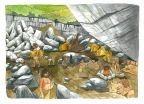The team could also demonstrate that farming was brought to Iberia by the same/similar groups that migrated to northern and central Europe and that the incoming farmers admixed with local, Iberian hunter-gather groups, a process that continued for at least 2 millennia.
The study is published today, ahead of print, in the leading scientific journal Proceedings of the National Academy of Sciences of the USA, PNAS.
Most of the previous studies about the transition from small and mobile hunter-gatherer groups to larger and sedentary farming populations have focused on central and northern Europe, however much less in known about how this major event unfolded in Iberia. This time, the research team investigated eight individuals associated with archaeological remains from farming cultures in the El Portalón cave from the well-known Anthropological site Atapuerca in northern Spain.
"The El Portalon cave is a fantastic site with amazing preservation of artefact material," says Dr. Cristina Valdiosera of Uppsala University and La Trobe University, one of the lead authors.
"Every year we find human and animal bones and artifacts, including stone tools, ceramics, bone artefacts and metal objects, it is like a detailed book of the last 10,000 years, providing a wonderful understanding of this period. The preservation of organic remains is great and this has enabled us to study the genetic material complementing the archaeology," Dr. Cristina Valdiosera continues.
From these individuals who lived 3,500-5,500 years ago, the authors generated the first genome-wide sequence data from Iberian ancient farmers and observed that these share a similar story to those of central and northern Europe. That is, they originate from a southern wave of expansion, and also admixed with local hunter-gatherer populations and spread agricultural practices through population expansions. The authors noticed that although they share these similarities with other European farmers, this early Iberian population has its own particularities.
"We show that the hunter-gatherer genetic component increases with time during several millennia, which means that later farmers were genetically more similar to hunter-gatherers than their forefathers who brought farming to Europe," says Dr. Torsten Günther of Uppsala University and one of the lead authors.
"We also see that different farmers mixed with different hunter-gatherer groups across Europe, for example, Iberian farmers mixed with Iberian hunter-gatherers and Scandinavian farmers mixed with Scandinavian hunter-gatherers." Dr. Cristina Valdiosera adds.
The study also reports that compared to all modern Spanish populations, the El Portalón individuals are genetically most similar to modern-day Basques. Basques have so far - based on their distinct culture, non-indo-European language, but also genetic make-up - been thought of as a population with a long continuity in the area, probably since more than 10,000 years ago.
"Our results show that the Basques trace their ancestry to early farming groups from Iberia, which contradicts previous views of them being a remnant population that trace their ancestry to Mesolithic hunter-gatherer groups," says Prof. Mattias Jakobsson of Uppsala University, who headed the study.
"The difference between Basques and other Iberian groups is these latter ones show distinct features of admixture from the east and from north Africa." he continues.
These findings shed light into the demographic processes taking place in Europe and Iberia during the last 5,000 years which highlights the unique opportunities gained from the collaborative work of archaeologists, anthropologists and geneticists in the analysis of ancient DNA.
"One of the great things about working with ancient DNA is that the data obtained is like opening a time capsule. Seeing the similarities between modern Basques and these early farmers directly tells us that Basques remained relatively isolated for the last 5,000 years but not much longer," says Dr. Torsten Günther.
INFORMATION:
Günther et al. (2015) Ancient genomes link early farmers from Atapuerca in Spain to modern-day Basques, PNAS
For more information please contact:
Mattias Jakobsson (Uppsala)
e-mail: mattias.jakobsson@ebc.uu.se
office: +46 18 4716449
cell: +46 767 698169
Torsten Günther (Uppsala)
e-mail: torsten.guenther@ebc.uu.se
office: +46 18 4714637
cell: +46 70 3905295
Cristina Valdiosera (Melbourne)
e-mail: cvaldioser@gmail.com
office: +61 394796575
cell: +61 416 000 657
Background
The Mesolithic/Neolithic transition is an important period in European prehistory since it represents a major change in subsistence strategies, notably the change from small and mobile hunter-gatherer groups to larger and sedentary farming populations. This transformation is arguably the basis of all complex sedentary societies and society as we know it today and it is often referred to as the Neolithic Revolution.
The origin and impact of agriculture in Europe has long been debated by archaeologists and has recently gained new insights from ancient DNA studies. We know that agricultural practices originated sometime around 11,000 years ago in the Middle East and the archaeological record shows that the 'Neolithic package' expanded into Europe and by 7,500 years ago, it had already reached most of Central Europe spreading later on into Scandinavia, the British Isles and along the Atlantic coast. However, it has long been debated whether the spread of these cultural and technological practices was achieved by spreading the idea of farming or by farmers populating the areas, that is via cultural or demic diffusion.
Different studies, including some from the same team reporting this new study, have already demonstrated, through ancient DNA evidence, that hunter-gatherers and ancient farmers are two genetically different groups, arguing for a population replacement of resident hunter-gatherers and therefore supporting the demic diffusion hypothesis. Some of these studies have also provided genomic evidence that Early Northern and Central European farmers are of southern origin. In addition, more recent genomic studies have shown that hunter-gatherers and farmers must have interbred and that both groups contributed to the modern day European gene pool.
Read more about the Jakobsson research group: Ancient DNA:
http://www.ieg.uu.se/jakobsson-se/?languageId=1
Extended image caption (related cave burial photo)
The unusual cave burial of the 6-year-old boy "Matojo" (ATP12-1420) from the Copper Age. The burial was found deliberately sheltered by large limestone blocks and three other blocks carefully protected the child´s head. The grave was scattered with grave goods suggesting a special status of this boy. The burial is covered by different ornaments, such as ceramics fragments of different sizes sealed with a green-like clay, vessel parts, flint flakes, a bone arrowhead, quartzite and, most surprisingly, the boy was left accompanied by an almost complete calf in anatomical position. This child possibly died of malnutrition as evidenced by a series of lesions in his skull and bones indicating the boy suffered from rickets and/or scurvy (Castilla et al, 2014) at different stages of his life. Credit: Eneko Iriarte



